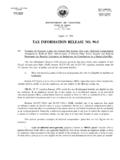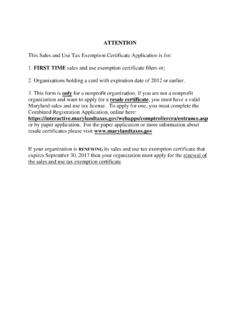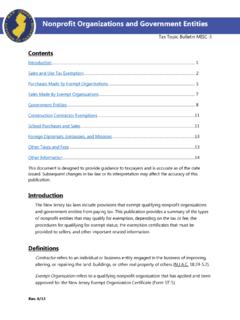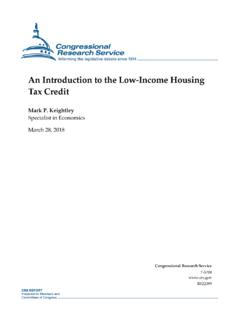Transcription of Tax Exempt and Government Entities 501 EXEMPT ...
1 501(c)(3)501(c)(3)501(c)(3)501(c)(3)501( c)(3)501(c)(3)APPLYING for 501(c)(3) Tax- EXEMPT Status Inside:Why apply for 501(c)(3) tax- EXEMPT status?Who is eligible for 501(c)(3) status?What responsibilities accompany 501(c)(3) status?How do you apply for 501(c)(3) status?Tax EXEMPT and Government EntitiesEXEMPT ORGANIZATIONSP ublication 4220 (Rev. 3-2018) Catalog Number 37053T Department of the Treasury Internal revenue Service Apply for 501(c)(3) Status? ..3 Who is Eligible for 501(c)(3) Status? ..3501(c)(3) Organizations ..4 Public Charities and Private Foundations ..5 What Responsibilities Accompany 501(c)(3) Status? ..6 Recordkeeping ..6 Filing Requirements ..6 Disclosure Requirements ..7 Recordkeeping Requirements ..8 How Do You Apply for 501(c)(3) Status?..8 When to File ..9 Determination Your Application is Do You Get IRS Assistance and Information?
2 10 Specialized Assistance for Tax- EXEMPT Organizations ..10 Tax Publications for EXEMPT Organizations ..11 Forms for EXEMPT Organizations ..122501(c)(3)Applying for 501(c)(3) Tax- EXEMPT Status,Federal tax law provides tax benefits to nonprofit organizations recognized as EXEMPT from federal income tax under section 501(c)(3) of the Internal revenue code (IRC). It requires that most organizations apply to the Internal revenue Service (IRS) for that status. This IRS Publication 4220 presents general guidelines for organizations that seek tax- EXEMPT status under IRC section 501(c)(3). Content includes references to the statute, Treasury Regulations, other IRS publications that explain the requirements for tax- EXEMPT status and IRS forms with instructions. Publication 4220 is neither comprehensive nor intended to address every situation. As an alternative to applying for exemption, an organization may obtain many of the benefits of 501(c)(3) status by affiliating with an existing charity that acts as its agent.
3 It is important to note that the existing charity must be given full control and author-ity over the program. To learn more about the rules and procedures that pertain to organizations applying for exemption from federal income tax under IRC section 501(c)(3), see Publication 557, Tax- EXEMPT Status for Your organization . For assistance on 501(c)(3) status, you may also want to consult a tax Apply for 501(c)(3) Status?The benefits of having 501(c)(3) status include exemption from federal income tax and eligibility to receive tax-deductible charitable contributions. To qualify for these benefits, most organizations must file an application with, and be recognized by, the IRS as described in this publication. Another benefit is that some organizations may be EXEMPT from certain employment and corporate donors are more likely to support organizations with 501(c)(3) status because their donations can be tax deductible.
4 Recognition of exemption under IRC section 501(c)(3) assures foundations and other grant-making institutions that they are issuing grants or sponsorships to permitted IRS determination of 501(c)(3) status is recognized and accepted for other purposes. For example, state and local officials may grant exemption from income, sales or property taxes. In addition, the Postal Service offers reduced postal rates to certain is Eligible for 501(c)(3) Status?There are three key components for an organization to be EXEMPT from federal income tax under IRC section 501(c)(3). A not-for-profit (in other words nonprofit) organization must be organized and operated exclusively for one or more EXEMPT purposes. Organized A 501(c)(3) organization must be organized as a corporation, trust or unincorporated association. An organization s organizing documents (articles of incorporation, trust documents, articles of association) must: limit its purposes to those described in IRC section 501(c)(3); not expressly permit activities that do not further its EXEMPT purposes, in other words unrelated activities; and, permanently dedicate its assets to EXEMPT Because a substantial portion of an organization s activities must further its EXEMPT purpose, certain other activities are prohibited or restricted including, but not limited to, the following activities.
5 A 501(c)(3) organization : must absolutely refrain from participating in the political campaigns of candidates for local, state or federal office; must restrict its lobbying activities to an insubstantial part of its total activities; must ensure that its earnings do not inure to the benefit of any private shareholder or individual; must not operate for the benefit of private interests such as those of its founder, the founder s family, its shareholders or persons controlled by these interests;4 must not operate for the primary purpose of conducting a trade or business that is not related to its EXEMPT purpose, such as a school s operation of a factory; and, must not have purposes or activities that are illegal or violate fundamental public policy. EXEMPT Purpose To be tax EXEMPT , an organization must have one or more EXEMPT purposes, stated in its organizing document.
6 IRC section 501(c)(3) lists the following EXEMPT purposes: charitable, educational, religious, scientific, literary, fostering national or international sports competition, preventing cruelty to children or animals, and testing for public safety. 501(c)(3) Organizations,The most common types of 501(c)(3) organizations are charitable, educational and organizations conduct activities that promote: - relief of the poor, the distressed or the underprivileged - advancement of religion - advancement of education or science - erection or maintenance of public buildings, monuments or works - lessening the burdens of Government - lessening neighborhood tensions - eliminating prejudice and discrimination - defending human and civil rights secured by law - combating community deterioration and juvenile delinquencyEDUCATIONALE ducational organizations include: - schools such as a primary or secondary school, a college, or a professional or trade school - organizations that conduct public discussion groups, forums, panels, lectures or similar programs - organizations that present a course of instruction by means of correspondence or through the use of television or radio- museums, zoos, planetariums, symphony orchestras or similar organizations- nonprofit day-care centers- youth sports organizations501(c)(3)5 RELIGIOUS,The term church includes synagogues, temples, mosques and similar types of organizations.
7 Although the IRC excludes these organizations from the requirement to file an application for exemption, many churches voluntarily file applications for exemption. This recognition by the IRS assures church leaders, members and contributors that the church is tax EXEMPT under IRC section 501(c)(3) and qualifies for related tax benefits. Other religious organizations that do not carry out the functions of a church, such as mission organizations, speakers organiza-tions, nondenominational ministries, ecumenical organizations or faith-based social agencies, may qualify for exemption. These organizations must apply for exemption from the IRS. See Publication 1828, Tax Guide for Churches and Religious Organizations, for more Charities and Private Foundations,Every organization that qualifies for tax- EXEMPT status under IRC section 501(c)(3) is further classified as either a public charity or a private foundation.
8 under IRC section 508(b), every organization is automatically classified as a private foundation unless it meets one of the exceptions listed in Sections 508(c) or 509(a).For some organizations, the primary distinction between a classification as a public charity or a private foundation is the organization s source of financial support. Generally, a public charity has a broad base of support while a private foundation has very limited sources of support. This classification is important because different tax rules apply to the operations of each. Deductibility of contributions to a private foundation is more limited than deductibility of contributions to a public charity. See Publication 526, Charitable Contributions, for more information on deductibility of contributions. In addition, private foundations are subject to excise taxes that are not imposed on public charities.
9 For more information about the special tax rules that apply to private foundations, see Publication 4221-PF, Compliance Guide for 501(c)(3) Private Foundations, and the Life Cycle of a Private Foundation statutorily classified as public charities under IRC section 509(a) are: churches; schools; organizations that provide medical or hospital care (including the provision of medical education and in certain cases, medical research); organizations that receive a substantial part of their support in the form of contributions from publicly supported organizations, governmental units and/or from the general public; organizations that normally receive not more than one-third of their support from gross investment income and more than one-third of their support from contributions, membership fees and gross receipts from activities related to their EXEMPT functions; and, organizations that support other public the organization requests public charity classification based on receiving support from the public, it must continue to seek significant and diversified public support 6in later years.
10 Beginning with the organization s sixth year of existence and for all succeeding years, the organization must demonstrate in its annual return that it receives the required amount of public support. If the organization does not meet the public support requirement, it could be reclassified as a private addition, to avoid unexpectedly losing its public charity classification, the organization should keep careful track of its public support information throughout the year, so that it will have the information it needs to complete Schedule A, Form 990 or 990-EZ. Unless the organization is committed to raising funds from the public, it may be more appropriate to consider an alternate statutorily based public charity classification. See Publication 557, Tax- EXEMPT Status for Your organization , for assistance with determining how your organization would be Responsibilities Accompany 501(c)(3) Status?

















